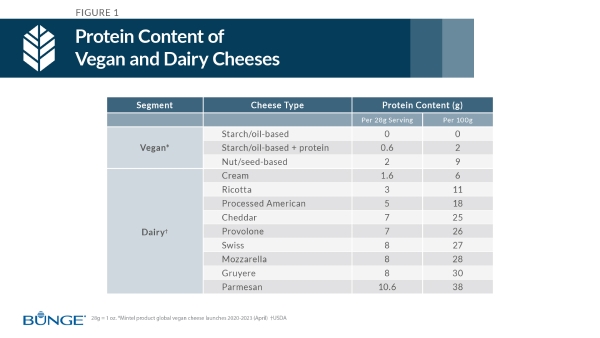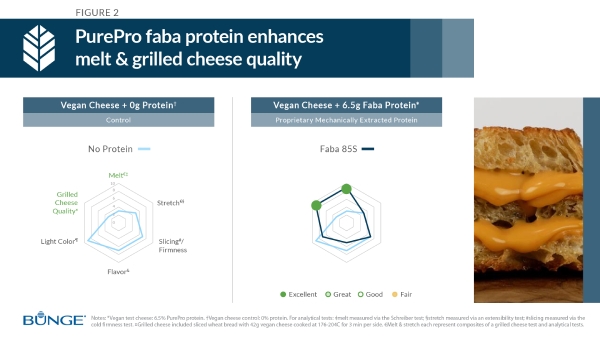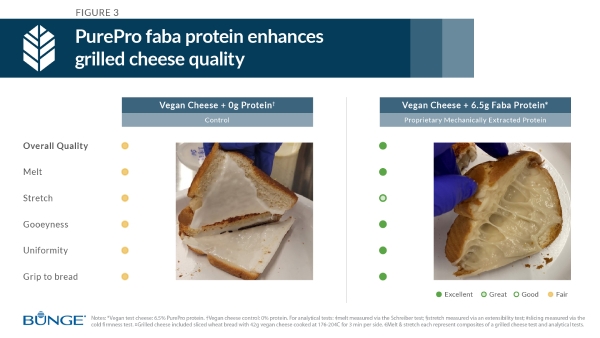Promotional Features
How to create exceptional vegan cheese with more protein
The next level of growth for vegan cheese will come from products closer in sensory and nutrition to dairy cheese.
Achieving this is not easy. It requires ingredients to deliver on the textural aspects of dairy cheese that consumers love – such as the melt of a perfect grilled cheese – while also serving as a foundational nutrient, like protein. Finding ingredients that can do both is a challenge, but not impossible, as we will see.
The market opportunity
Global volume demand for vegan cheese grew by 13% per year between 2019 and 2022, greatly exceeding dairy cheese’s flat performance during the same period. Still, this growth resulted in vegan cheese owning less than 1% share of the global cheese market in 2022. Benchmarking this against the milk category, where dairy-free commanded 7% volume share globally in 2022, suggests that significant room for growth exists for plant-based cheeses.1
Considering that meaningfully-sized segments of consumers claim to have the same or similar preference for dairy and plant-based milks, it can be concluded that vegan cheese needs to deliver a dairy-like sensory experience to achieve continued growth.
In fact, we know from recent data from the Plant Based Foods Association and the data insights group 84.51o that consumers are still seeking better vegan cheese options. In a recent survey they conducted together, 73% of respondents agreed with the statement, “I wish there was a better plant-based cheese alternative that tasted like regular cheese, melted well, and didn’t have a grainy texture.”2,3
It is clear that the eating experience must be a top priority in formulating vegan cheeses, but many developers also struggle to find the right balance between the sensory experience and nutrition. Brands that can find this sweet spot will elevate the growth of the plant-based cheese market.
Closing the nutrition gap in vegan cheese
A key nutritional shortfall of vegan cheese is the protein gap versus dairy cheese. Protein is a core nutrient of most dairy cheese, but the majority of vegan cheese offerings contain little or no protein. For instance, between April 2020 and April 2023, 62% of vegan cheese launches globally were oil and starch based. Two-thirds of these had no protein, while one-third contained very small levels of protein from extracts of pea, potato, chickpea, and other botanicals. The remaining 38% of vegan cheese launches during the same period were made with nuts and/or seeds, which contributed a higher content of protein, though still significantly less than most dairy cheeses.
Boosting vegan cheeses with plant proteins are often associated with a common set of challenges. This includes introducing into the cheese a beige or greyish colour, a beany or astringent flavour, and/or a grainy texture. Such undesired features are barriers to the use of these proteins in vegan cheeses.
However, not all plant proteins are created equally. Many factors affect their sensory and functional properties, including the type of botanical, growing location, environmental aspects, processing methods, and supply chain conditions. Closely controlling each of these is important for creating a high-quality protein for excellent vegan cheese.
The features of such a protein include neutral taste and colour, high solubility, lower emulsification, and medium viscosity. These collectively increase the likelihood of producing a great tasting vegan cheese that is smooth and creamy, and that melts extremely well. Such a protein will also help close the protein gap between plant-based and dairy cheeses while maintaining or enhancing the taste, texture, and appearance of finished products.
The plant protein solution for exceptional vegan cheese
PurePro faba protein from Bunge is an ideal plant protein for vegan cheese brands seeking to deliver a higher content of protein alongside a highly appealing eating experience – including melt, gooeyness, and other desired qualities of heated applications.
In lab tests, adding PurePro faba protein to starch and oil-based vegan cheeses at 2g per 28g serving (6.5g per 100g) significantly improved melt and overall grilled cheese quality compared to a protein-free control. In the Schreiber test, melt distance increased from 3mm in the control to 9mm with the addition of PurePro faba protein (Figure 2). In a grilled cheese application, PurePro faba protein delivered excellent melt, gooeyness, uniformity, and grip to bread compared to a fair performance of these parameters in the protein-free control (Figure 3).
Contributing to PurePro faba protein’s success is the way in which it is made. This starts with selecting the highest quality Australian faba beans, and extracting protein from them via a gentle process that’s proprietary and free from solvents and enzymes. The outcome is a protein with an optimized balance of neutral taste and texture, high solubility, lower emulsification, and medium viscosity. Such features underpin key benefits in vegan cheese, such as high solubility for smooth texture, lower emulsification for excellent melt, and medium viscosity for a luxurious mouthfeel.
Overall, PurePro faba protein contributes 2g protein per 28g serving (6.5g per 100g), allowing vegan cheese brands to get closer nutritionally to the dairy cheese standard, and allowing consumers to enjoy an ooey-gooey grilled cheese, mouthwatering pizza, or indulgent croque monsieur made from plants.
Vegan cheese formulators interested in testing PurePro faba protein in their formulations can learn more at Bunge.com/plant-based.
References
1. Euromonitor (total global volume demand in retail and foodservice between 2019 and 2022 for plant-based cheese, dairy cheese, plant-based milk, dairy milk).
2. Cardello et al, Plant-based alternatives vs dairy milk: consumer segments and their sensory, emotional, cognitive and situational use responses to tasted products. Food Quality and Preference 100 (2022) 104599.
3. 84.51 and the Plant Based Food Association. Unmet Needs: Insights & Solutions (2023).
4. Mintel (global product launches between Jan 2020 and May 2023 for retail cheeses claiming to be vegan, plant-based, or dairy-free)






